- Initial results from the first 18 holes of the 2023 program have confirmed the connection between Boundary Main and Boundary West.
- These results reveal a continuous mineralized zone of stratiform laminated to massive sulphide in addition to extensive near-surface vein and breccia mineralization.
- The Boundary Zone stratiform mineralization has a strike length of over 400 m and has been followed down-dip for at least 350 metres.
- This zone is trending to higher grades and greater thicknesses at depth, where it remains open.
- NB23-003 intersected 71.89 m of 6.48% zinc, 3.09% lead, 97.8 g/t silver, including 21.96 m of 10.70% zinc, 6.96% lead, and 178.6 g/t silver.
- NB23-001 intersected 38.00 m of 9.12% zinc, 1.50% lead, 52.6 g/t silver, including 20.00 m of 15.32% zinc, 2.53% lead, 86.2 g/t silver.
- NB23-002 intersected 4.20 m of 18.71% zinc 0.30% lead 47.1 g/t silver.
Vancouver, British Columbia: FIREWEED METALS CORP. (“Fireweed” or the “Company”) (TSXV: FWZ; OTCQB: FWEDF) is pleased to report the first assay results from its 2023 exploration at the Macmillan Pass Project, Yukon, and provide an update from its largest ever drill program.
CEO Statement
Brandon Macdonald, CEO, stated “The first results of the season have already been a game-changer for Fireweed, demonstrating the presence of a high-grade layer of massive sulphides and stratiform mineralization feeder system which connects Boundary West and Boundary Main in one single zone which we are now just calling Boundary. We are delighted with the 2023 drill program so far, and we are excited to continue drilling step-outs in and around this potential feeder, as well as the other step-out targets at Boundary, Tom, Jason, and beyond.”
Initial Results from the Boundary Feeder Zone Target
The initial phases of the 2023 drilling program have targeted a gap in the drilling between two of Fireweed’s best‑ever drillholes at Boundary Zone, NB22-002 and NB22‑023, where Fireweed has been testing a high-grade feeder zone target that was interpreted to link Boundary West and Boundary Main within a sediment hosted massive sulphide system. These 2022 holes intersected very wide, high-grade zones and flank either side of the target being tested in Phase 1 of the 2023 drill program: NB22-023 intersected 298 m of 4.5% zinc, 1.4% lead, and 30.9 g/t silver including a stratiform zone of 9.6 m grading 24.5% zinc, 15.1% lead, and 323.2 g/t silver; and hole NB22-002 intersected 124 m at 12.3% zinc, 1.3% lead, 45.9 g/t silver (see Fireweed news releases dated November 22, 2022, and March 2, 2023).
Table 1: Assay results for the first three holes of the 2023 drilling program, Boundary Zone.

The 2023 step-outs completed so far have successfully intersected pyrite-sphalerite-galena as stratiform massive sulphides, laminated mineralization, replacement mineralization, veins, and breccias. Assays have been received for the first three holes and are reported in this news release (Tables 1 and 2) along with visual summaries for an additional 17 holes that have tested targets at Tom and Boundary Zone (Table 3).
Hole NB23-003 intersected 72 m of massive sulphide grading 6.48% zinc, 3.09% lead, and 97.8 g/t silver that is interpreted to be a successful test of the conceptual feeder zone target.
Hole NB23-001 intersected sphalerite and galena mineralization, with a 38 m intercept of semi-massive sulphide correlated with the stratiform layer of mineralization grading 9.12% zinc, 1.5% lead, and 52.6 g/t silver.
Hole NB23-002 intersected a 4.2 m, high-grade, interval of semi-massive sulphide containing 18.71% zinc.
See Tables 1, 2 and 3, Long Section M-M’, Cross Section H–H’, Cross Section J–J’ Section K–K’ Section L–L’ and Maps 2 & 3 below for further details.
Additional step-out drilling in the area between the Boundary Main and Boundary West zones has continued to intersect wide intervals of zinc-lead mineralization with assays pending. Hole NB23‑012 intersected 48 m of feeder-style massive sulphide representing a 40 m step-out immediately along strike to the southeast from hole NB23-003. Hole NB23-016 intersected 67 m of massive sulphides 95 m down-dip from NB23-003. In the footwall of the Boundary Ramp fault, hole NB23‑007 intersected 119 m of massive sulphide, hole NB23-011 intersected 47.6 m of massive sulphide and breccia, and hole NB23-013 intersected 24.5 m of massive sulphide. These intersections correlate with hole NB22-002—one of Fireweed’s best intercepts—which is now thought to correlate to the broad zone of mineralization seen in hole NB23-003.
The geometry and stratigraphic sequence intersected in the first 18 holes that have tested the target between Boundary Main and Boundary West strongly suggest that intersections of laminated stratiform mineralization and massive sulphide zones are part of the same geological layer and support the interpretation of spatial and grade continuity between the drillholes, connecting the two zones in three dimensions. High lead-silver grades and the presence of galena suggest that a feeder zone may exist at Boundary Zone and that the lead-rich intersections reported here may be located in or near the feeder zone. This is a preliminary interpretation of the available geological data and will be further tested by additional drilling in 2023, with additional step-outs to provide a deeper test of the stratiform layer.
2023 Drill Program Drilling Update
The 2023 program is utilizing five diamond drill-rigs, targeting over 16,000 m of drilling mostly focused on Boundary, Tom, and Jason zones (Map 1) with >8,000 m completed thus far. The drill program will focus on step-out targets at Boundary Zone, Jason, and Tom, as well as test several exploration targets away from the known zones.
Drill penetration rates in the first 20 holes was between 30–50% faster than historical performance. The region experienced an early snowmelt this year, allowing a second rig to be mobilized weeks earlier than planned. Three additional rigs have been mobilized and now a total of five rigs are coring on the project.
Camp Expansion Update
The new 48-person camp expansion is commissioned and occupied. Both camps are operating smoothly with a total of roughly 96 people on site. Together with the existing camp, the new all-weather camp allows Fireweed to support around 100 people on site to complete the 2023 season objectives. This work is an important step to build out Macmillan Pass camp capacity to the approved capacity of 150 people, allowing for both larger drill programs and simultaneous environmental baseline studies and occupancy during colder months.
About Fireweed Metals Corp. (TSXV: FWZ; OTCQB: FWEDF; FSE:20F): Fireweed Metals is a public mineral exploration company on the leading edge of Critical Minerals project development. Fireweed is well-funded, with a healthy working capital position, and is well-positioned to carry out the large 2023 exploration program. The Company has three projects located in Canada:
- Macmillan Pass Project (Zinc-Lead-Silver): Fireweed owns 100% of the district-scale 940 km2 Macmillan Pass project in Yukon, Canada, which is host to one of the largest undeveloped zinc resources in the world** where the Tom and Jason zinc-lead-silver deposits have current Mineral Resources1 (11.21 Mt Indicated Resource at 6.59% zinc, 2.48% lead, and 21.33 g/t silver; and 39.47 Mt Inferred Resource at 5.84% zinc, 3.14% lead, and 38.15 g/t silver) and a Preliminary Economic Assessment2 (PEA). In addition, Boundary Zone, Tom North and End Zone have significant zinc-lead-silver mineralization drilled but not yet classified as mineral resources. The project also includes large blocks of adjacent claims with known showings and significant upside exploration potential.
- Mactung Project (Tungsten): The Company recently acquired 100% interest in the 37.6 km2 Mactung Project located adjacent to the Macmillan Pass Project. Recently announced mineral resources for Mactung (41.5 Mt Indicated Resource at 0.73% WO3 and 12.2 Mt Inferred Resource at 0.59% WO3)* make it the world’s largest high-grade resource of the Critical Mineral tungsten**. Located in Canada, it is one of the rare large tungsten resources outside of China.
- Gayna River Project (Zinc-Lead-Gallium-Germanium): Fireweed has 100% of the 128.75 km2 Gayna River project located 180 km north of the Macmillan Pass project. It is host to extensive mineralization including Critical Minerals zinc, gallium and germanium as well as lead and silver, outlined by 28,000 m of historical drilling and significant upside potential.
Qualified Person Statement
Technical information in this news release has been approved by Fireweed’s VP Geology, Dr. Jack Milton, P.Geo. (BC), a ‘Qualified Person’ as defined under Canadian National Instrument 43-101.
In Canada, Fireweed (TSXV: FWZ) trades on the TSX Venture Exchange. In the USA, Fireweed (OTCQB: FWEDF) trades on the OTCQB Venture Market (www.otcmarkets.com) and is DTC eligible for enhanced electronic clearing and settlement. In Europe, Fireweed (FSE: 20F) trades on the Frankfurt Stock Exchange.
Additional information about Fireweed and its projects can be found on the Company’s website at FireweedMetals.com and at www.sedar.com.
ON BEHALF OF FIREWEED METALS CORP.
“Brandon Macdonald”
CEO & Director
Contact: Brandon Macdonald
Phone: (604) 646-8361
Email: info@fireweedmetals.com
Neither the TSX Venture Exchange nor its Regulation Services Provider (as that term is defined in the policies of the TSX Venture Exchange) accepts responsibility for the adequacy or accuracy of this release.
Data verification
The diamond drill core logging and sampling program was carried out under a rigorous quality assurance / quality control program using industry best practices. Drill intersections in this release are NQ2 size core (50.5 mm/ 1.99-inch diameter) with recoveries typically above 85% unless otherwise noted in the results tables. After drilling, core was cleaned, logged for geology, structure, and geotechnical characteristics, then marked for sampling and photographed on site. Certain cores were selected for core scanning. The cores for analyses were marked for sampling based on geological intervals with individual samples 2 m or less in length, with 1 m samples within mineralized zones. Drill core was cut lengthwise in half with a core saw; half-core was sent for assays reported in this news release, and the other half is stored on site for reference. Bulk density was determined on site for the entire length of each sample assayed by measurement of mass in air and mass in water. Sample duplicate bulk density determinations and in-house bulk density standard determinations were each made at a rate of 5%. Since 2017, four in-house bulk density standards (mineralized drill core from the Tom deposit that span a range of densities) have been used and show an acceptable long-term precision. Certified standard masses are used to calibrate the scale balance used for bulk density determinations.
A total of 5% assay standards or blanks and 5% core duplicates are included in the sample stream as a quality control measure and are reviewed after analyses are received. Standards and blanks in 2023 drill results to date have been approved as acceptable. Duplicate data add to the long-term estimates of precision for assay data on the project and precision for drill results reported is deemed to be within acceptable levels. Samples were sent to the Bureau Veritas preparation laboratory in Whitehorse, Yukon, where the samples were crushed and a 500 g split was sent to the Bureau Veritas laboratory in Vancouver, B.C to be pulverized to 85% passing 200 mesh size pulps. Clean crush material was passed through the crusher and clean silica was pulverized between each sample. The pulps were analyzed by 1:1:1 Aqua Regia digestion followed by Inductively Coupled Plasma Mass Spectrometry (ICP-ES/ICP-MS) multi-element analyses (BV Code AQ270). All samples were also analyzed for multiple elements by lithium borate fusion and X-ray fluorescence analysis (XRF) finish (BV Code LF725). Over-limit lead (>25.0%) and zinc (>24.0%) were analyzed by lithium borate fusion with XRF finish (BV Code LF726). Silver is reported in this news release by method AQ270, and zinc and lead are reported by LF725 or LF726. Bureau Veritas (Vancouver) is an independent, international ISO/IEC 17025:2005 accredited laboratory.
Results in this news release are length and bulk-density weighted averages as would be used in a Mineral Resource estimate. Length and bulk-density weighted averages have been reported as these most accurately represent the average metal-content of the intersections.
True widths are estimated by measuring perpendicular to strike within the short axis of a stratiform wireframe that has been constructed in 3D around the mineralized intercepts at Boundary Zone based on assay results, geological logging, stratigraphic correlation, and bedding measurements from oriented core. The massive sulphide mineralization and laminated mineralization at Boundary Zone are mostly stratiform (oriented parallel to bedding), therefore the true width, or thickness, of the zone is estimated perpendicular to both the strike and dip direction of bedding. Vein and breccia mineralization at Boundary Zone are interpreted to be stockworks and true widths are estimated to be approximately equal to intersected widths and marked as N/A in the assay tables.
Sphalerite and galena have been identified visually by experienced core logging geologists, and licenced professional geoscientists, confirmed by portable XRF (X-Ray fluorescence). No absolute visual estimates of mineral abundances or inferences of potential zinc or lead grades have been stated for holes without assay values in this news release.
Cautionary Statements
Forward Looking Statements
This news release contains “forward-looking” statements and information (“forward-looking statements”). All statements, other than statements of historical facts, included herein, including, without limitation, statements relating to interpretation of drill results and projections of mineralization, future work plans, the use of funds, and the potential of the Company’s projects, are forward looking statements. Forward-looking statements are frequently, but not always, identified by words such as “expects”, “anticipates”, “believes”, “intends”, “estimates”, “potential”, “possible”, and similar expressions, or statements that events, conditions, or results “will”, “may”, “could”, or “should” occur or be achieved. Forward-looking statements are based on the beliefs of Company management, as well as assumptions made by and information currently available to Company management and reflect the beliefs, opinions, and projections on the date the statements are made. Forward-looking statements involve various risks and uncertainties and accordingly, readers are advised not to place undue reliance on forward-looking statements. There can be no assurance that such statements will prove to be accurate, and actual results and future events could differ materially from those anticipated in such statements. Important factors that could cause actual results to differ materially from the Company’s expectations include but are not limited to, exploration and development risks, unanticipated reclamation expenses, expenditure and financing requirements, general economic conditions, changes in financial markets, the ability to properly and efficiently staff the Company’s operations, the sufficiency of working capital and funding for continued operations, title matters, First Nations relations, operating hazards, political and economic factors, competitive factors, metal prices, relationships with vendors and strategic partners, governmental regulations and oversight, permitting, seasonality and weather, technological change, industry practices, uncertainties involved in the interpretation of drilling results and laboratory tests, and one-time events. The Company assumes no obligation to update forward‐looking statements or beliefs, opinions, projections or other factors, except as required by law.
Footnotes and References
*See Fireweed news release dated June 13, 2023 “Fireweed Metals Announces Mineral Resources for the Mactung Project: the Largest High-Grade Tungsten Deposit in the World”. The associated technical report will be filed on www.SEDAR.com on or before July 28, 2023
** References to relative size and grade of the Mactung resources and Macmillan Pass resources in comparison to other tungsten and zinc deposits elsewhere in the world, respectively, are based on review of the Standard & Poor’s Global Market Intelligence Capital IQ database.
1: Fireweed Technical Report titled “NI 43-101 Technical Report on the Macmillan Pass Zinc-Lead-Silver Project, Watson Lake and Mayo Mining Districts Yukon Territory, Canada” filed on www.SEDAR.com on Feb 23, 2018, and Fireweed News Release dated January 10th 2018.
2: Fireweed Technical Report titled “NI 43-101 Technical Report Macmillan Pass Project Yukon Territory Canada” filed on www.SEDAR.com on July 9th 2018, and Fireweed News Release dated May 23rd, 2018. This Technical Report includes a Preliminary Economic Analysis disclosing an economic analysis of mineral resources that is preliminary in nature and does not include any mineral reserves. It is equally emphasized that the mineral resources disclosed within this Technical Report are not mineral reserves and do not have demonstrated economic viability.
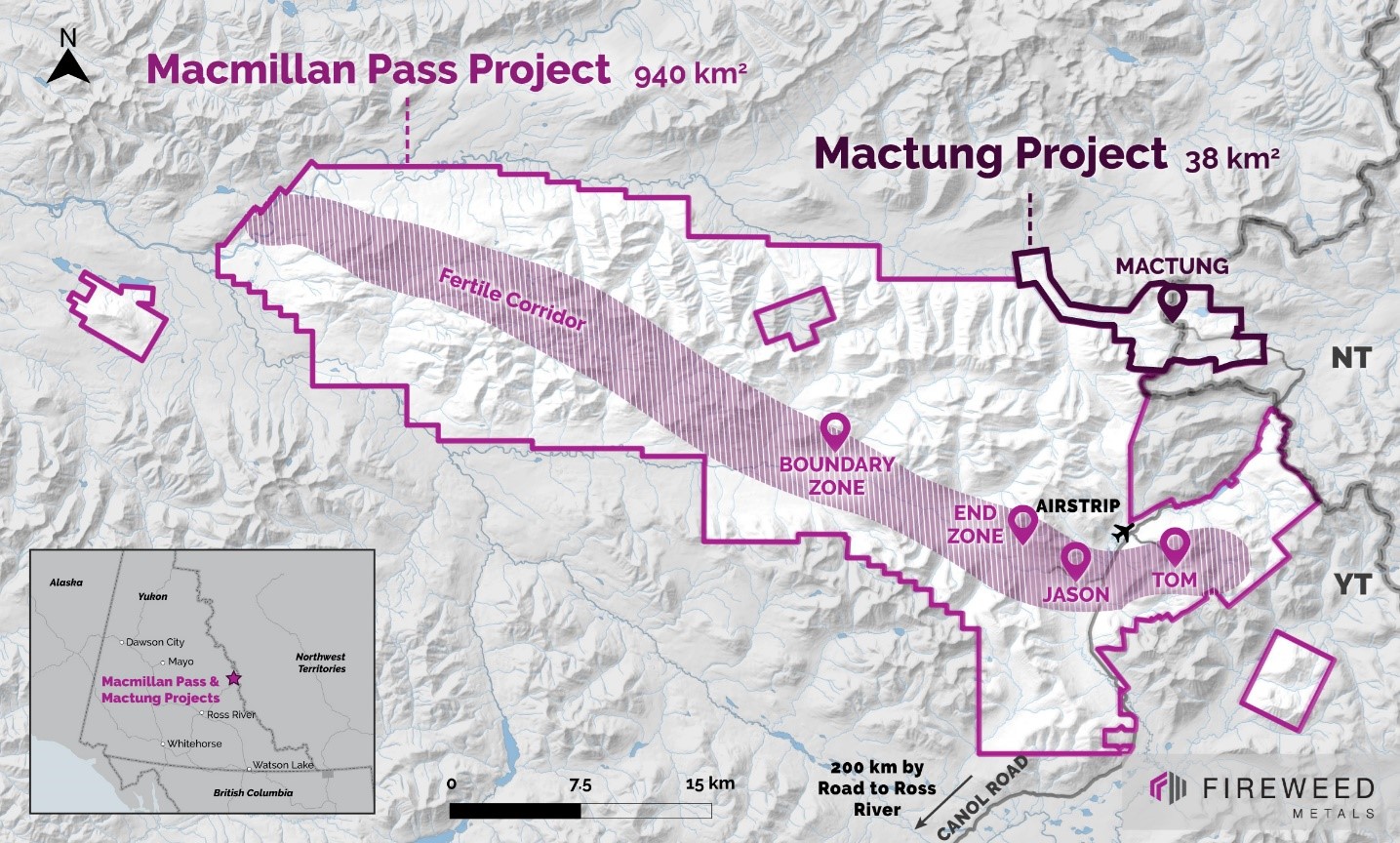 Map 1: Macmillan Pass Project and Mactung Project locations.
Map 1: Macmillan Pass Project and Mactung Project locations.
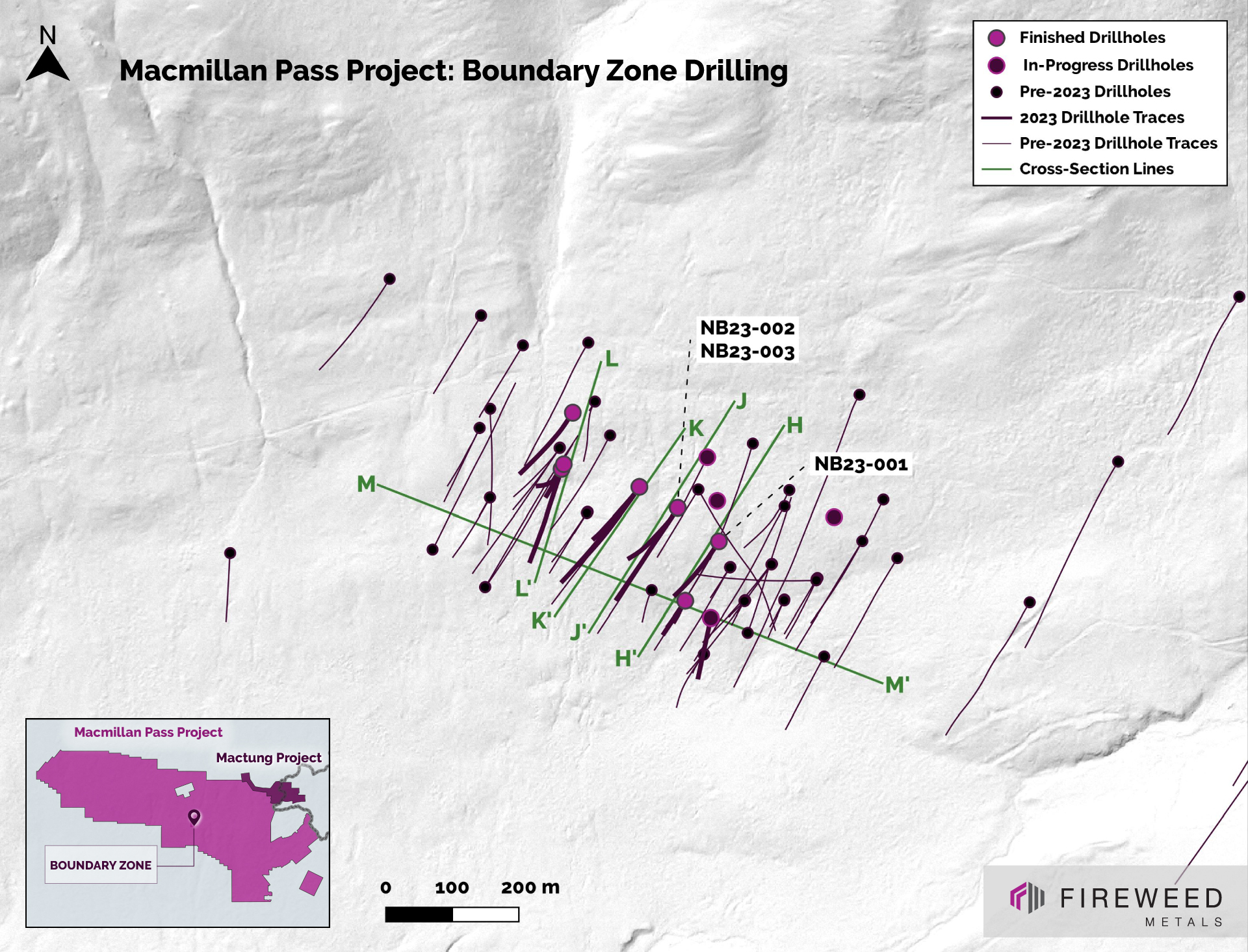 Map 2: Location of 2023 Boundary Zone drillholes, cross section H–H’, J–J’, K–K’, L–L’ and long section M–M’ see below for cross sections.
Map 2: Location of 2023 Boundary Zone drillholes, cross section H–H’, J–J’, K–K’, L–L’ and long section M–M’ see below for cross sections.
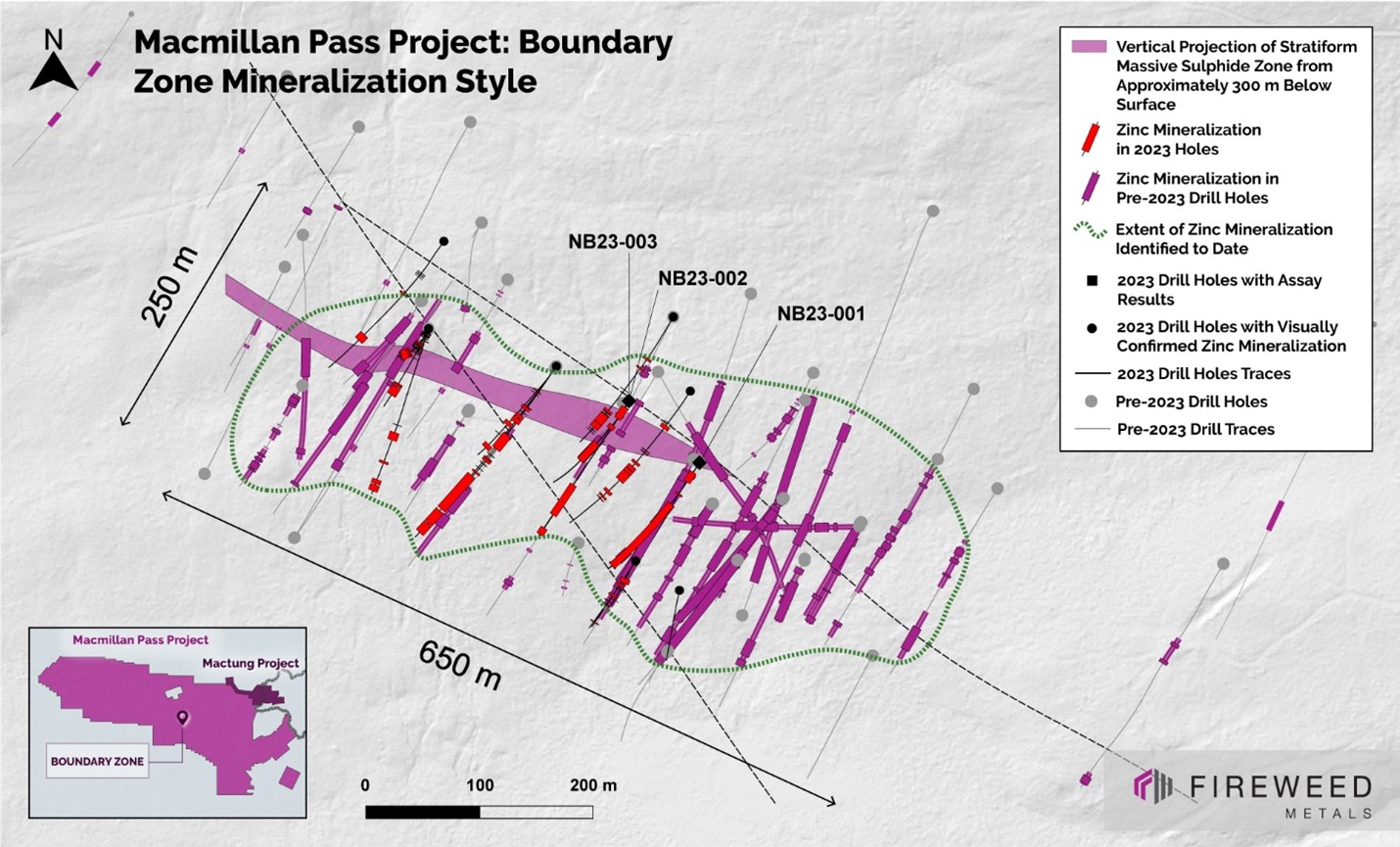 Map 3: Mineralized intervals in 2023 drilling and pre-2023 drilling defining a stratiform laminated to massive sulphide zone that is connected at depth (pink polygon) and a broader envelope of vein, breccia, and other stratiform zinc mineralization, showing significant areal extent (within green dashed line).
Map 3: Mineralized intervals in 2023 drilling and pre-2023 drilling defining a stratiform laminated to massive sulphide zone that is connected at depth (pink polygon) and a broader envelope of vein, breccia, and other stratiform zinc mineralization, showing significant areal extent (within green dashed line).
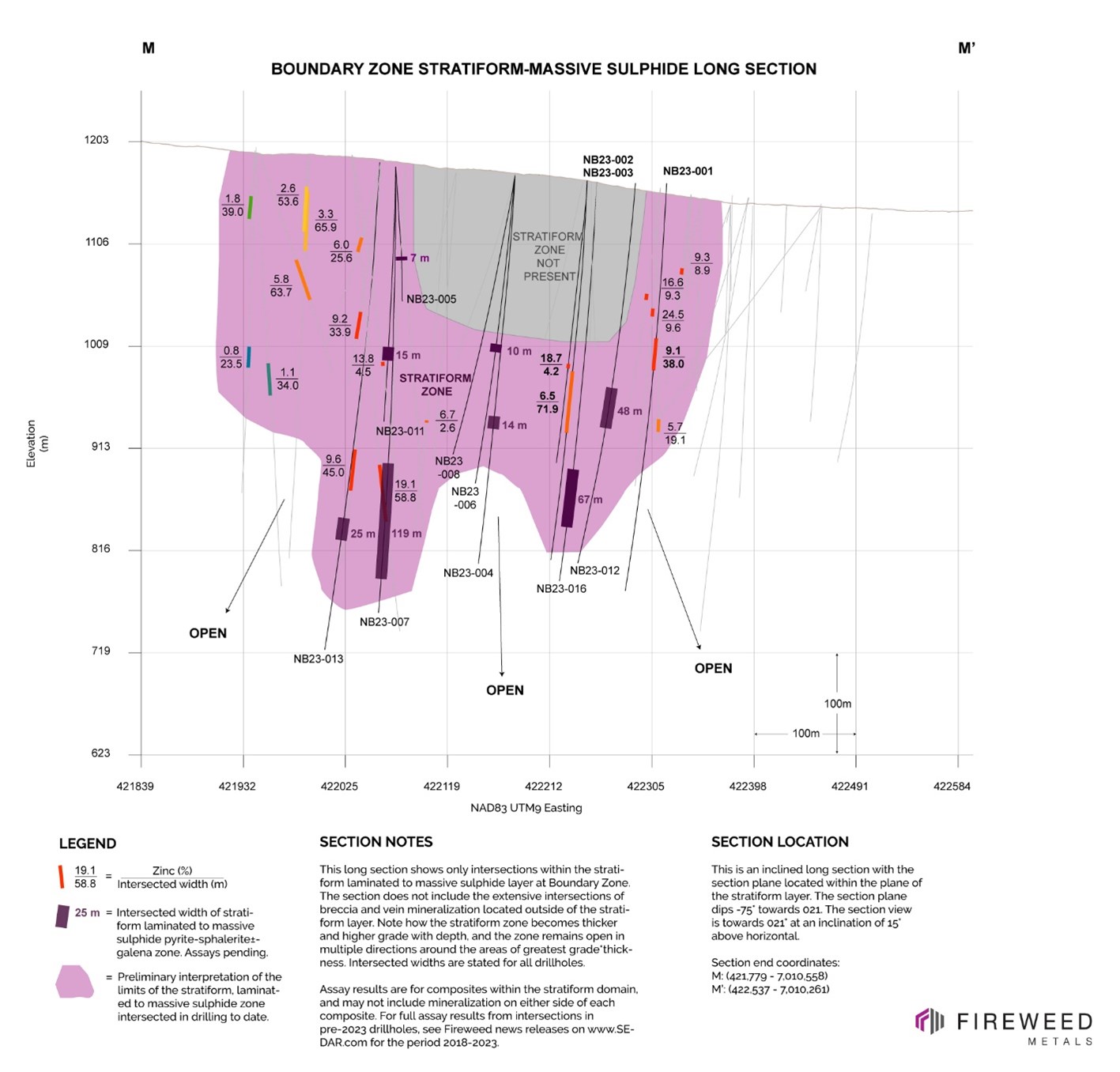 Long Section M–M’ – Selected intersections within the laminated to massive sulphide stratiform zone of pyrite-sphalerite-galena mineralization at Boundary Zone including long intervals of zinc mineralization at depth with assays pending.
Long Section M–M’ – Selected intersections within the laminated to massive sulphide stratiform zone of pyrite-sphalerite-galena mineralization at Boundary Zone including long intervals of zinc mineralization at depth with assays pending.
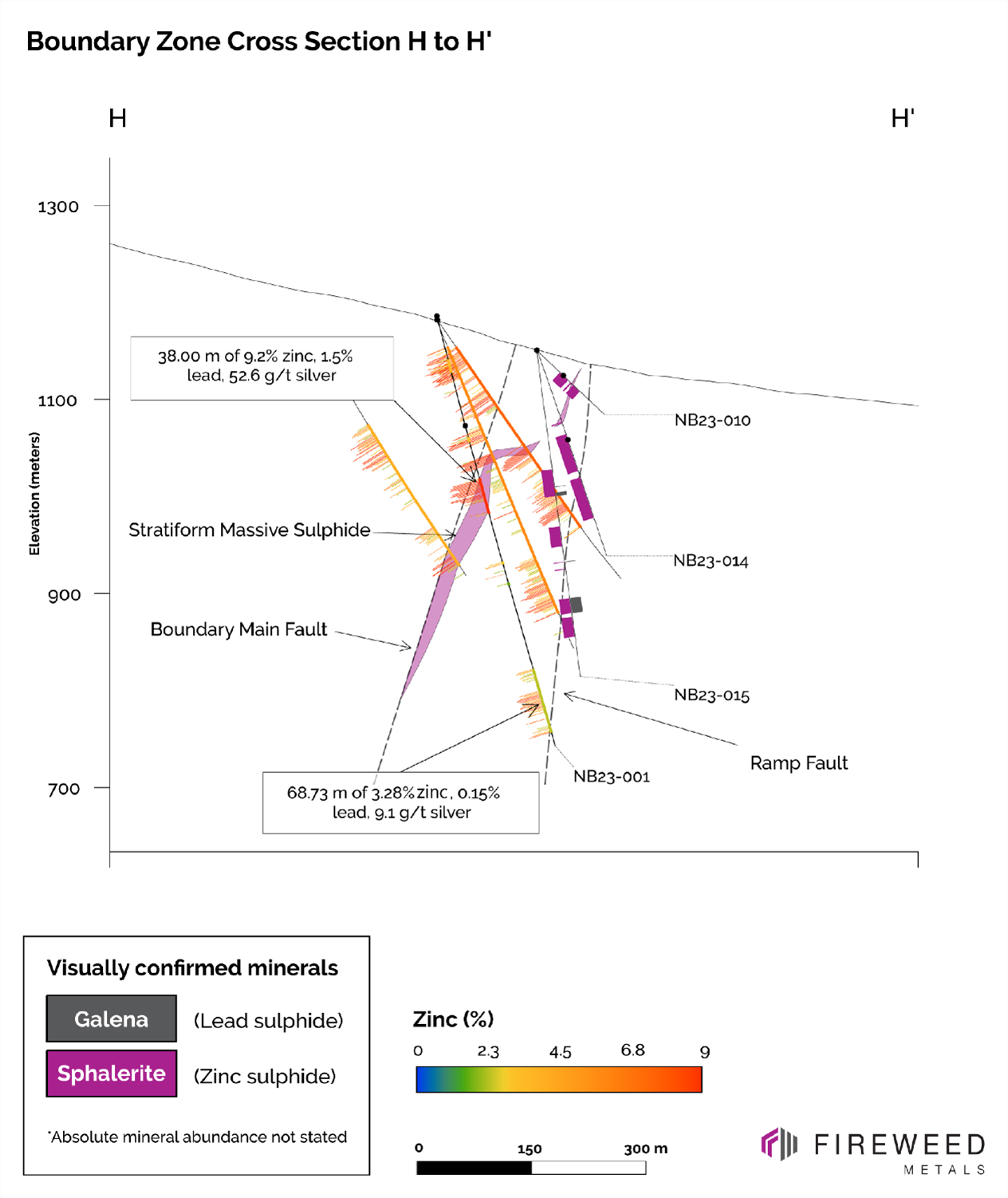 Cross Section H–H’—Assay results from the first hole of the 2023 season, NB23-001, intersecting high-grade new stratiform zone (purple) in the footwall of the Boundary Main Fault, high-grade vein and breccia mineralization above the Boundary Main Fault, and volcaniclastic-hosted mineralization at depth. Also see intersections of mineralization with assays pending in holes NB23-010, NB23-014, and NB23-015.
Cross Section H–H’—Assay results from the first hole of the 2023 season, NB23-001, intersecting high-grade new stratiform zone (purple) in the footwall of the Boundary Main Fault, high-grade vein and breccia mineralization above the Boundary Main Fault, and volcaniclastic-hosted mineralization at depth. Also see intersections of mineralization with assays pending in holes NB23-010, NB23-014, and NB23-015.
 Cross Section J-J’ Wide intersection of massive sulphides steps-out the stratiform mineralized zone down-dip with high grades in NB23-003, and a wide interval in NB23-016 (assays pending). Preliminary interpretation of the approximate shape of the stratiform mineralized zone shown in purple.
Cross Section J-J’ Wide intersection of massive sulphides steps-out the stratiform mineralized zone down-dip with high grades in NB23-003, and a wide interval in NB23-016 (assays pending). Preliminary interpretation of the approximate shape of the stratiform mineralized zone shown in purple.
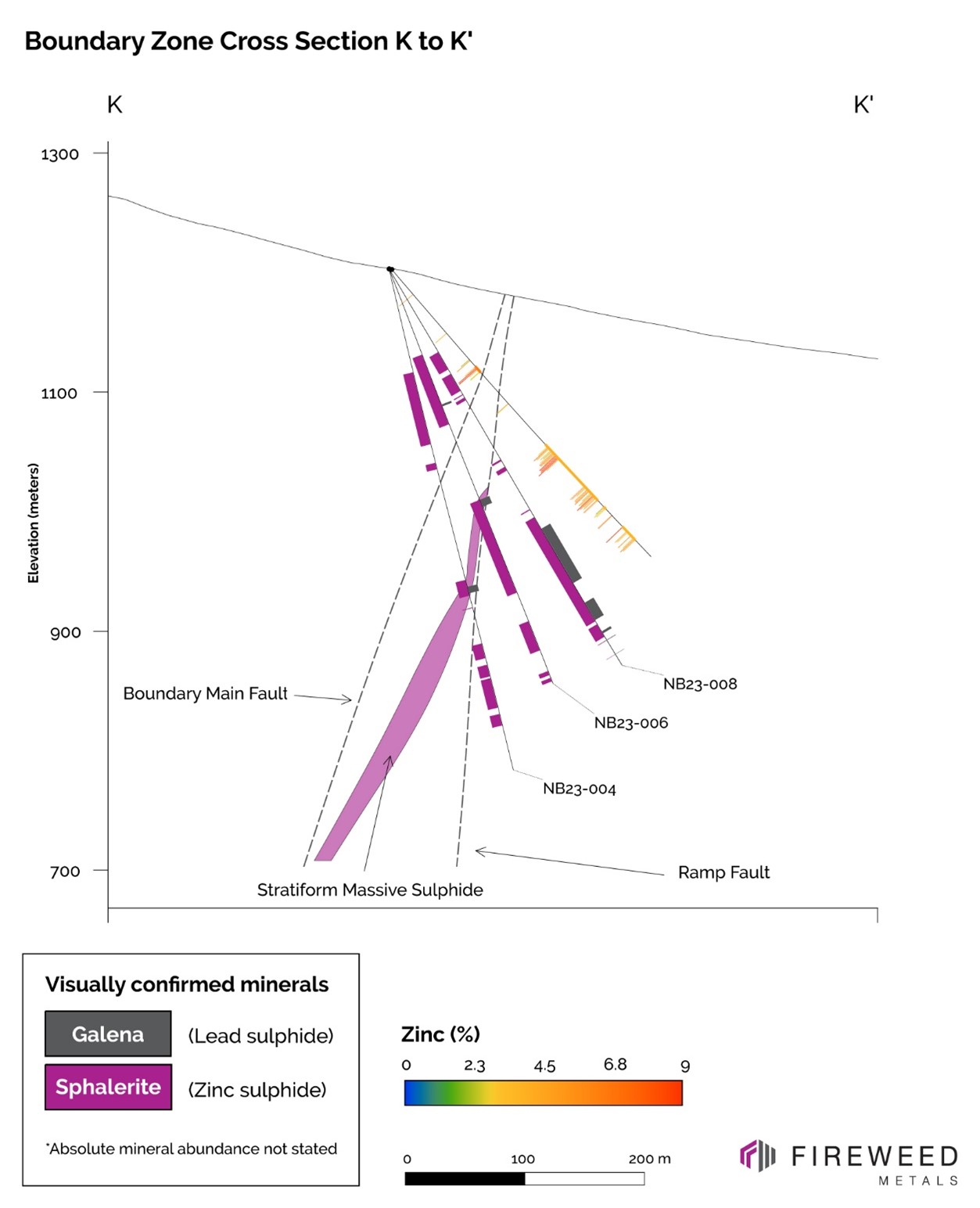 Cross Section K-K’: Mineralized intersections with assays pending in holes NB23-004, NB23-006, and NB23-008.
Cross Section K-K’: Mineralized intersections with assays pending in holes NB23-004, NB23-006, and NB23-008.
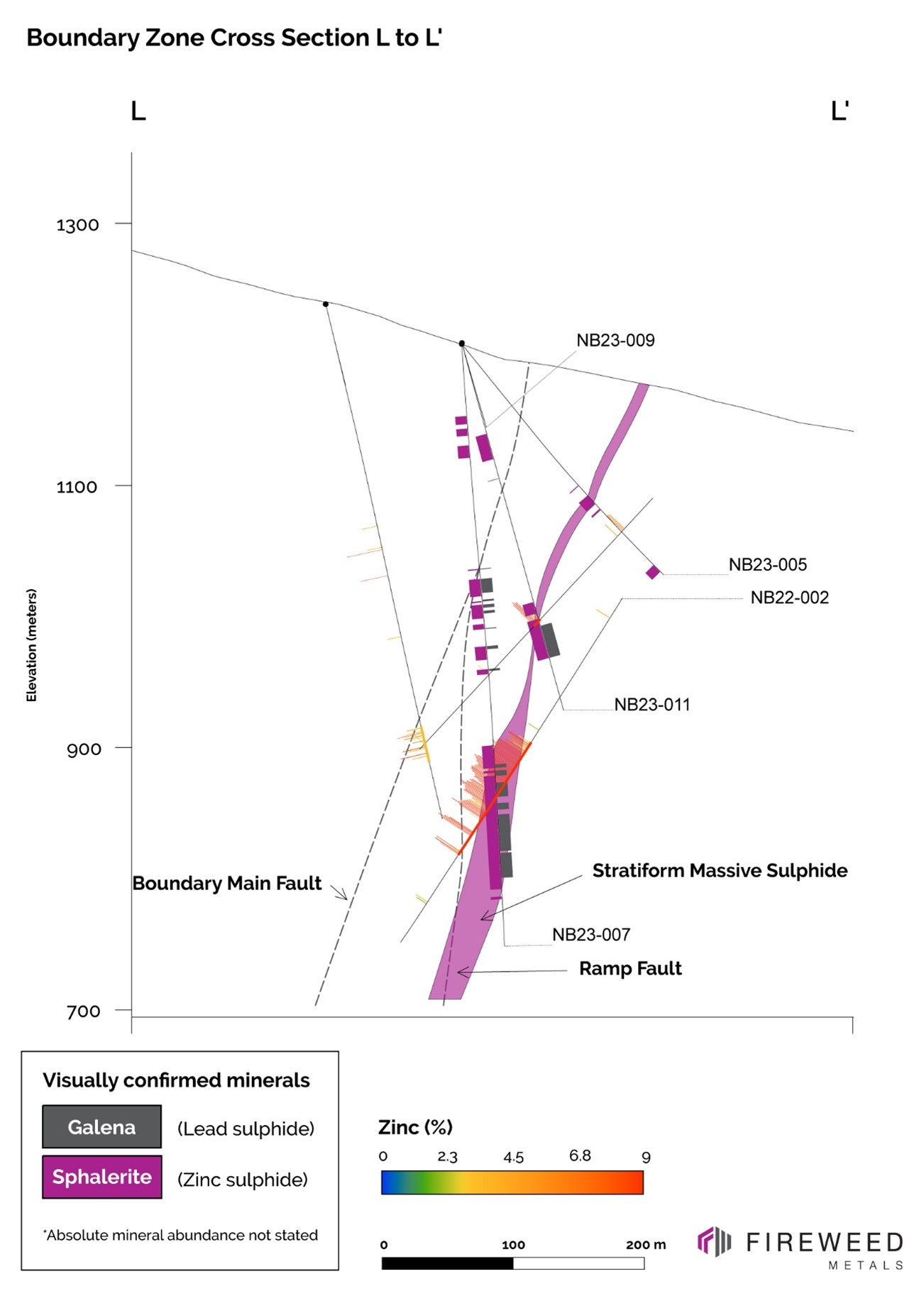 Cross Section L-L’: Mineralized intervals with assays pending in NB23-007, NB23-011, and NB23-005, including a very long interval of massive sulphide in hole NB23-007 following up from NB22-002.
Cross Section L-L’: Mineralized intervals with assays pending in NB23-007, NB23-011, and NB23-005, including a very long interval of massive sulphide in hole NB23-007 following up from NB22-002.
Table 2: NB23-001, NB23-002 and NB23-003 drill results.

Table 3: 2023 drilling summary.

Table 4: Drill Hole Collar Information.


